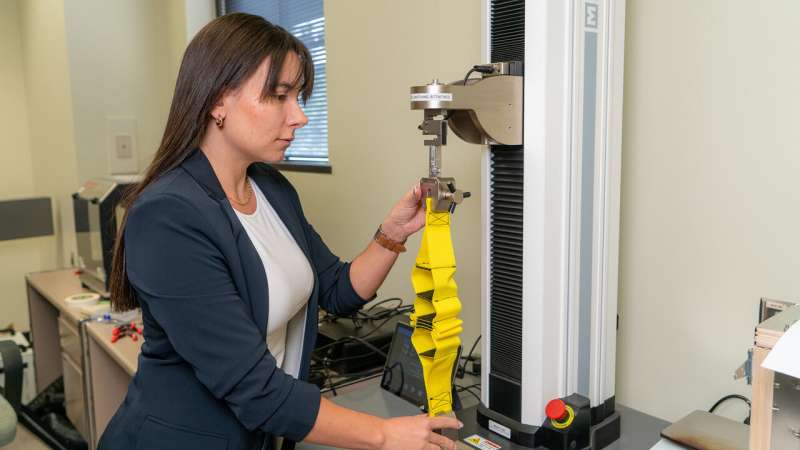This article has been reviewed according to Science X's editorial process and policies. Editors have highlighted the following attributes while ensuring the content's credibility:
fact-checked
trusted source
proofread
Bio-inspired materials showcase potential for protective equipment and textiles

Bio-inspired materials (BIM) are synthetic materials whose structure and properties are similar to natural materials or living matter. These materials have the potential to advance structural materials, textiles and protective equipment due to their durability and self-healing properties.
Dr. Vanessa Restrepo, assistant professor in the J. Mike Walker '66 Department of Mechanical Engineering, and her team at the Bio-Inspired Materials (BIM) Lab aim to create bio-inspired materials with enhanced behaviors by focusing on the nature of proteins to develop the sacrificial bond composites (bonds that break before the main structural link is broken) utilizing non-linear adhesive materials.
This article was published in Materials & Design.
This research could significantly impact electrical wired infrastructure in adverse weather conditions. Using these materials, the cables could stretch and extend to bear the additional weight of ice accumulation or sudden tree falls caused by strong winds. This flexibility could prevent cable breakage, meaning less interruptions in electrical service.
"Our commitment remains dedicated to advancing bioinspired materials and their applications in various industries," said Restrepo. "We're enthusiastic about these materials' potential impact and contribution to more resilient and sustainable product development."
According to Restrepo, non-linear adhesives refer to a force-displacement behavior that deviates from a bilinear path, in contrast to conventional adhesives. Unlike traditional adhesives, the force-displacement relationship of non-linear adhesives does not follow a straightforward, two-stage pattern. Instead, it exhibits a more complex and variable behavior as external forces are applied.
To approach this research, Restrepo is using a cross-scale strategy, integrating non-linear adhesive materials and opposite-facing magnets to form sacrificial bond composites similar to those found in proteins such as the nacre's interface, which is a multilayered brick-and-mortar natural material 3000 times more resistant to fracture than its constituents.
Their approach involves utilizing sacrificial bond composites that mimic natural biological mechanisms, allowing for energy dissipation and self-healing upon mechanical failure. The external load breaks the sacrificial bonds of sacrificial bond composites, and the opposite-facing magnets bring together the separated interface, allowing the reforming of its sacrificial bonds and the self-repairing of the composite after sustaining large strains.
"This differs significantly from current materials that lack these intrinsic self-repairing abilities, resulting in single-use and disposable products," she said. "Our proposed research looks at the possibility of creating multiuse self-repairing energy dissipation mechanisms, such as Fall Arresters."
Incorporating these innovative materials could result in longer-lasting, more cost-effective, and more sustainable products that require less frequent replacement, eventually resulting in the development of self-repairing materials used in various everyday items, such as protective equipment and textiles.
The BIM lab partnered with Dr. Ramses Martinez, associate professor at Purdue University, to conduct this research. This method was recently patented by Restrepo and team.
More information: Vanessa Restrepo et al, Cross-scale design of energy dissipative composites using self-repairing interfaces based on sacrificial bonds, Materials & Design (2023). DOI: 10.1016/j.matdes.2023.112283
Provided by Texas A&M University





















